Journal list menu
News: Archive
April 01, 2021
Our Pledges on Diversity, Equity, and Inclusion
In our open letter in June, we made six pledges for making Angewandte Chemie a more inclusive and diverse journal. Our commitment to making the journal an inclusive home for excellent science remains strong, and we will continue to work to fulfil and exceed these pledges. Here is an update of the progress that has been made so far (as of April 2021).
Pledge 1: Assemble a diverse group of external advisors to evaluate our current processes and aid in the creation of new ones that aim to eliminate the potential for discrimination and foster diversity at all levels.
This work is currently underway. The first step was a bibliometric analysis, which is completed and will soon be released. We are adding DE&I advocates and experts to the new International Advisory Board. Details will be announced in a few months.Pledge 2: Be transparent with the findings of both our internal and external review.
Please see our open letter and editorial from October and November 2020, where we describe the findings of the internal review. The Committee on Publication Ethics (COPE) recently published a related report, which we shared through social media. We will continue to be open and transparent with the community.
Pledge 3: Launch a Diversity, Equity and Inclusion (DE&I) training program for the journal leadership team.
The Executive Editors have received focused training, and team members have participated in Wiley’s DE&I training initiatives, with more to come in the next few months.
Pledge 4: Focus on building more diversity within the Editorial and Advisory Boards.
We're working with the Gesellschaft Deutscher Chemiker (GDCh, German Chemical Society) to recruit a diverse group of Advisory Editors and to rebuild the Editorial and International Advisory Boards into a single international, diverse board to support the in-house team of professional editors. We’ll be sharing more details in the coming months.
Pledge 5: Develop new editorial guidelines incorporating DE&I principles and practices.
We have discontinued the News and Author Profiles sections as they did not represent the diversity of the chemistry community. We plan to relaunch them in the future with a stronger emphasis on the teams behind the work, and with a commitment to a broader selection of the many voices of the community. The refereeing process for opinion-based articles has been changed to include DE&I experts in the refereeing process. We have revised the reviewer selection process for all article types to expand the pool of active reviewers and reduce the potential for bias. The editorial procedures for appeals have been revised and made available to authors. Our team members were instrumental in developing Wiley's new author name change policy.
Pledge 6: Create forums for external dialogues on DE&I issues, partnering with relevant associations in driving the conversation.
This is a work in progress. So far we've been holding events, such as one for the IUPAC Global Women’s Breakfast, and partnering across the industry, but there is still more to do. We will continue to seek opportunities to have these important conversations centered around action.Theresa Kueckmann, Frank Maaß, Neville Compton, Xin Su, Suzanne Tobey, Nathalie Weickgenannt
Executive Editors
October 05, 2020
Initiating Change at Angewandte Chemie
Since Angewandte Chemie’s June publication of the opinion piece "“Organic Synthesis—Where now?” is thirty years old. A reflection on the current state of affairs," our team has been reflecting, learning, and planning. We have engaged in many conversations and have listened to authors and readers. In our last letter to you, we promised transparency and action to better our journal and advocate to drive meaningful change inside of the community. We have begun a journey of awareness, analysis and action, and although there is more work to be done, we wanted to keep you updated on where we stand today.
We continue to grow awareness of our own biases and of how systemic bias affects scholarly communication and the scientific community. Members of the editorial leadership have received training to address unconscious bias, and workshops have been held with the editorial team. This has also been a central theme of meetings with the German Chemical Society (GDCh), which owns the journal. Wiley is currently engaged in broad and systematic work to bring diversity, equity and inclusion (DE&I) to everything we do, and a robust, wide-reaching training plan is being developed. We have pledged alongside the Royal Society of Chemistry and many others to further DE&I inside of scholarly communications.
Only by gaining a deep understanding of the current situation can we identify the most impactful solutions to pressing problems. An internal investigation conducted according to the guidelines of the Committee on Publication Ethics (COPE) found that the breakdown in editorial decision-making resulted from a convolution of several factors: The editor did not pay the necessary attention to the offending passages; the reviewers were selected for their subject expertise in chemistry and not for their ability to evaluate other aspects of the essay; the procedures for evaluating opinion pieces were insufficiently robust, as no guidance was provided to reviewers on how to review opinion pieces, particularly regarding the topics of race, ethnicity, and gender. COPE is currently validating the findings of our internal process, and we will share those conclusions when we are able.
We are also pleased that Professor Hans-Dieter Daniel (University of Zurich) has accepted an invitation to conduct an independent analysis on the journal’s peer review and editorial decision-making process. Dr Daniel’s scholarly interests include quantitative studies of science with a focus on peer review research and evaluative bibliometrics. He is among others author of the case study "Guardians of Science: Fairness and Reliability of Peer Review", which examined the peer review process of Angewandte Chemie in the 1980s. He is undertaking an initial analysis and is designing an independent research project to track diversity parameters at Angewandte Chemie on a retrospective and—even more important—prospective basis. Following the analysis, we will engage with DE&I experts to address any results that show a lack of inclusive thinking.
We are also making changes in the journal leadership to ensure that Angewandte Chemie’s transformation into a driving force for diversity, equity and inclusion continues with momentum in the coming months and years. An Executive Committee of editors has been installed to lead the journal in place of a single Editor-in-Chief. This structure of joint decision-making and shared responsibility encourages diversity of opinion and counteracts individual bias. Within the committee, Theresa Kueckmann is responsible for the strategic direction of the journal and its commitment to diversity, equity, and inclusion and for the implementation of the change necessary to achieve these goals. Frank Maass and Nathalie Weickgenannt are responsible for the scientific and editorial content of the journal and for peer review and editorial decision-making on submitted manuscripts. Neville Compton has an operational role in managing the editorial office. Xin Su brings the views of the Asian community to the committee and represents the journal to researchers in Asia. An additional position with a similar remit for the Americas is still to be filled.
In addition to changing the leadership structure of the journal, Wiley and the GDCh have revisited the external governance structure. We have agreed to assemble a group of leading scientists from around the world as Advisory Editors to support our team of experienced professional editors. Together with the GDCh, we will rebuild the International Advisory Board into a highly diverse body that represents different voices within our community. The highest officers of the GDCh will engage with the Executive Committee on a monthly basis to ensure progress on our joint commitment to drive diversity.
Our dedication to building a more inclusive journal remains strong. The Executive Committee will share their work on this goal in an upcoming editorial. We look forward to sharing the results of our ongoing analyses as they become available, and how we will use these results as we continue to build out future plans.
Prof. Dr. Annette Beck-Sickinger, Editorial Board Chair, Angewandte Chemie
Dr. Guido F. Herrmann, VP & Managing Director, Wiley-VCH
Prof. Dr. Peter R. Schreiner, President, German Chemical Society (GDCh)
June 18, 2020
Editorial: From Scientists to Scientists—Moving Angewandte into the Future
By Annette G. Beck-Sickinger, Thomas Carell, Stefanie Dehnen, Walter Leitner, Peter R. Schreiner, and Helma Wennemers (Members of the Editorial Board of Angewandte Chemie and members of the German Chemical Society (GDCh) Presiding Committee)
On June 4, 2020, an Essay entitled “‘Organic synthesis—Where now?’ is thirty years old. A reflection on the current state of affairs” was published on the website of Angewandte Chemie as an “Accepted Article”. The article expressed offending views about women and other groups underrepresented in science. In addition, the Chinese research community was unjustly defamed. It contained a description of mentorship in science that contravenes the values of good working practice and education. The article was withdrawn by the editors from Wiley Online Library on June 5, according to the COPE (Committee on Publication Ethics) guidelines and standards adopted across the publishing sector from the STM Association (International Association of Scientific, Technical and Medical Publishers), and two editors were suspended on June 6.
The article should have never been published.
June 09, 2020
An Open Letter to Our Community
On 4 June, an opinion piece was published in Angewandte Chemie that contained offensive and inflammatory language aimed toward people of different genders, races, and nationalities.
We apologize that this offensive and misguided essay was published in our journal, and we are deeply sorry for failing the community that puts their trust in us. The views expressed in the essay do not reflect the values of the journal in any way. That this article was published at all has demonstrated a breakdown in editorial decision-making.
We responded swiftly, not just to right this wrong and correct an editorial mistake, but also to take a hard-look at ourselves. As part of our path forward, we have taken the following actions:
- Suspended two senior editors and removed two referees from our selection of peer reviewers
- Introduced a new process for peer-reviewed opinion pieces, including a requirement that reviewers are expert in the topic of the essay rather than experts in the field or focus of the journal
- Established an interim editorial decision-making structure, effective immediately (read more about this newly appointed team below)
- Removed the article from the journal’s website and launched an internal review according to the guidelines of the Committee on Publication Ethics (COPE)
We recognize and take very seriously the role we play in the academic system. Today, we also pledge to:
- Assemble a diverse group of external advisors to evaluate our current processes and aid in the creation of new ones that aim to eliminate the potential for discrimination and foster diversity at all levels
- Be transparent with the findings of both our internal and external review
- Launch a Diversity, Equity and Inclusion (DE&I) training program for the journal leadership team
- Focus on building more diversity within the Editorial and Advisory boards
- Develop new editorial guidelines incorporating DE&I principles and practices
- Create forums for external dialogues on DE&I issues, partnering with relevant associations in driving the conversation
Strong action is of the utmost importance. Improving DE&I at Angewandte Chemie will not stop here. As a journal and as a community, we must take an inward look at how we can meaningfully contribute to the dismantling of an often-biased academic system. Diversity only strengthens science, and inclusive science that reflects the world’s best thinking is our greatest hope for solving the problems facing society.
We’ll continue to share updates on our progress and welcome your involvement in helping us shape a more fair and inclusive system. We will take an active leadership role in becoming a beacon for DE&I. You have our promise that we will make significant strides forward.
Dr. Guido Herrmann
VP & Managing Director, Wiley-VCH
Announcing New Angewandte Chemie Interim Editor-in-Chief Committee
We are pleased to announce the appointment of an interim Editor-in-Chief Committee, effective immediately. This group will:
- Hold full Editorial responsibility for Angewandte Chemie.
- Consist of the current Deputy Editors Nathalie Weickgenannt and Frank Maaß, joined by Theresa Kueckmann and Xin Su (bios see below).
- Jointly oversee the editorial processes to ensure strict adherence to best editorial practice.
- Act centrally to implement necessary steps to strengthen diversity and earn back the trust of our community.
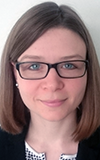 Nathalie Weickgenannt studied chemistry at the University of Oxford, completing her MChem degree with research into chiral fluorinating reagents in the group of Véronique Gouverneur. She went on to complete her PhD in the field of organocatalysis under the supervision of Frank Glorius (Universität Münster) and joined Angewandte Chemie in 2013. She has been Deputy Editor of the journal since October 2018.
Nathalie Weickgenannt studied chemistry at the University of Oxford, completing her MChem degree with research into chiral fluorinating reagents in the group of Véronique Gouverneur. She went on to complete her PhD in the field of organocatalysis under the supervision of Frank Glorius (Universität Münster) and joined Angewandte Chemie in 2013. She has been Deputy Editor of the journal since October 2018.
 Frank Maaß studied chemistry at the Technische Universität Darmstadt, Germany, where he also completed his PhD in the field of atmospheric chemistry in 1999 under the supervision of Prof. Horst Elias. He joined Wiley-VCH in 1999 and worked as an Assistant, Associate, and Senior Associate Editor for Angewandte Chemie before he was promoted to Deputy Editor of the journal in 2018.
Frank Maaß studied chemistry at the Technische Universität Darmstadt, Germany, where he also completed his PhD in the field of atmospheric chemistry in 1999 under the supervision of Prof. Horst Elias. He joined Wiley-VCH in 1999 and worked as an Assistant, Associate, and Senior Associate Editor for Angewandte Chemie before he was promoted to Deputy Editor of the journal in 2018.
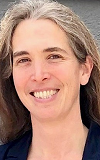 Theresa Kueckmann studied chemistry at the University of Minnesota, conducting research on bioinorganic model complexes in the group of Bill Tolman. She then moved to Germany, where she completed an MS at the Freie Universität Berlin, doing research on rhenium oxo complexes for radiopharmaceutical therapy with Ulrich Abram. She was awarded her PhD by the Goethe-Universität Frankfurt for a thesis on transition-metal complexes of silylchalcogenolates with Matthias Wagner. She joined Wiley-VCH in 2007 and worked five years at Angewandte Chemie before being named Editor of Chemistry—An Asian Journal in 2012. In addition to Chemistry—An Asian Journal, she is responsible for a portfolio of journals that Wiley-VCH publishes with Asian and European societies in the chemical sciences.
Theresa Kueckmann studied chemistry at the University of Minnesota, conducting research on bioinorganic model complexes in the group of Bill Tolman. She then moved to Germany, where she completed an MS at the Freie Universität Berlin, doing research on rhenium oxo complexes for radiopharmaceutical therapy with Ulrich Abram. She was awarded her PhD by the Goethe-Universität Frankfurt for a thesis on transition-metal complexes of silylchalcogenolates with Matthias Wagner. She joined Wiley-VCH in 2007 and worked five years at Angewandte Chemie before being named Editor of Chemistry—An Asian Journal in 2012. In addition to Chemistry—An Asian Journal, she is responsible for a portfolio of journals that Wiley-VCH publishes with Asian and European societies in the chemical sciences.
 Xin Su received his BSc in chemistry from Nankai University in 2009. He then moved to the USA and conducted graduate research on hydrazone-based molecular switches and functional materials at Dartmouth College where he received his PhD in organic chemistry in 2013. Following postdoctoral training at the National Energy Technology Laboratory in Pittsburgh, he worked as an associate editor for Wiley's materials science journals including Advanced Materials from 2015 to 2017. After spending a year at SpringerNature as a senior editor of Nature Chemistry, Xin joined the editorial team of Angewandte Chemie in 2018.
Xin Su received his BSc in chemistry from Nankai University in 2009. He then moved to the USA and conducted graduate research on hydrazone-based molecular switches and functional materials at Dartmouth College where he received his PhD in organic chemistry in 2013. Following postdoctoral training at the National Energy Technology Laboratory in Pittsburgh, he worked as an associate editor for Wiley's materials science journals including Advanced Materials from 2015 to 2017. After spending a year at SpringerNature as a senior editor of Nature Chemistry, Xin joined the editorial team of Angewandte Chemie in 2018.
June 05, 2020
A Statement from the Editor-in-Chief
An opinion essay “A Reflection on the Current State of Affairs,” a response to “Organic synthesis—Where Now?,” originally published 30 years ago in Angewandte Chemie, recently appeared as an Accepted Article. The opinions expressed in this essay do not reflect our values of fairness, trustworthiness and social awareness. It is not only our responsibility to spread trusted knowledge, but to also stand against discrimination, injustices and inequity. While diversity of opinion and thoughts can spur change and debate, this essay had no place in our journal.
In response to this incident, we will conduct an internal investigation and will share the actions we are implementing within the next week to ensure this will not happen again. We are deeply sorry and know we have failed the community that puts their trust in us.
The foundation of our work is based on the belief that science can and does change the world.
We are committed to making a change. We can and will do better.
Dr. Neville Compton
Editor-in-Chief, Angewandte Chemie
June 21, 2017
Neville Compton to Succeed Peter Gölitz as Editor-in-Chief of Angewandte Chemie
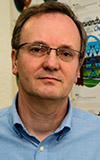 The German Chemical Society (GDCh) and Wiley-VCH would like to announce that Dr. Neville Compton will take over as Editor-in-Chief of Angewandte Chemie from October 1, 2017. Angewandte Chemie, the flagship journal of the GDCh, is a weekly publication steeped in tradition; the German edition is in its 129th volume, and the International Edition in its 56th.
The German Chemical Society (GDCh) and Wiley-VCH would like to announce that Dr. Neville Compton will take over as Editor-in-Chief of Angewandte Chemie from October 1, 2017. Angewandte Chemie, the flagship journal of the GDCh, is a weekly publication steeped in tradition; the German edition is in its 129th volume, and the International Edition in its 56th.
Dr. Neville Compton studied chemistry at the University of Newcastle Upon Tyne, carried out postdoctoral research at the University of Heidelberg, and joined the editorial team of An-gewandte Chemie in 1992 at the age of 27. In 1997 he was promoted to Deputy Editor, and in 2002 he became also the Editor-in-Chief of Chemistry—A European Journal. Under Dr. Compton's editorship this journal has become one of the most important chemistry journals; Chemistry—A European Journal is the pre-eminent journal of ChemPubSoc Europe, an organization comprising 16 European chemical societies.
After 37 years working for Angewandte Chemie, 35 of which as Editor-in-Chief, Dr. Peter Gölitz is retiring. Under his leadership, Angewandte Chemie transformed from a national to a leading international journal; in 2016 the top four countries in terms of published papers in Angewandte Chemie were USA, China, Germany, and Japan. Peter Gölitz shaped the journal by attracting top authors from around the world and by developing the magazine section.
July 08, 2011
When Friends Celebrate Excellent Chemistry ... you can still join online!
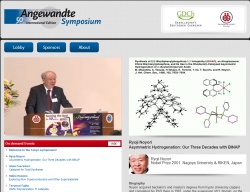 With symposia in Tokyo and Beijing, the German, Japanese, and Chinese chemical societies and publishers Wiley-VCH celebrated the 50th volume of Angewandte Chemie International Edition. The journal has become a leading publication in original chemical research over the past 20 years. "Angewandte Live" was the motto of the events, which featured chemistry Nobel laureates Ryoji Noyori, K. Barry Sharpless, Hartmut Michel, and Akira Suzuki as key speakers. They were joined by the Alexander von Humboldt Foundation's president Helmut Schwarz, himself a renowned chemist, and other leading chemists from Germany and Switzerland. Three local speakers were presented by both the Chemical Society of Japan and the Chinese Chemical Society, true to Angewandte's principle of "quality first".
With symposia in Tokyo and Beijing, the German, Japanese, and Chinese chemical societies and publishers Wiley-VCH celebrated the 50th volume of Angewandte Chemie International Edition. The journal has become a leading publication in original chemical research over the past 20 years. "Angewandte Live" was the motto of the events, which featured chemistry Nobel laureates Ryoji Noyori, K. Barry Sharpless, Hartmut Michel, and Akira Suzuki as key speakers. They were joined by the Alexander von Humboldt Foundation's president Helmut Schwarz, himself a renowned chemist, and other leading chemists from Germany and Switzerland. Three local speakers were presented by both the Chemical Society of Japan and the Chinese Chemical Society, true to Angewandte's principle of "quality first".
The celebrations coincided with the 150th anniversary of official relations between Germany and Japan, anniversaries of the symposia hosts: the Tokyo Institute of Technology (130 years) and Tsinghua University (Beijing; 100 years), Wiley-VCH (90 years), Wiley office locations in Singapore (30 years) and Beijing (10 years), and the International Year of Chemistry. There were really plenty of reasons to celebrate.
Topics featured ranged from catalysis and synthesis to advanced materials and chemical biology. In addition, the event promoted ties between German and Asian chemists, sponsored by "Research in Germany", an initiative which funds the international exchange of researchers through numerous member organizations (DFG, AvH, DAAD etc). The symposia were attended by about 500 people in each location. "I congratulate you on the successful Angewandte symposia in TITech and Tsinghua University," commented Professor Noyori (pictured) afterwards.
More than 3,000 people registered for the internet broadcasts. The recordings have been archived and are free to view at ChemistryViews. "It was just like being there as I watched Helmut Schwarz's clear and effervescent talk," wrote a participant of the broadcast.
Learn more and watch the lectures now.
October 05, 2009
Nobel Prize 2009 in Physiology or Medicine to Blackburn, Greider, and Szostak—Background Reading
The Nobel Assembly at Karolinska Institutet has today decided to award the Nobel Prize in Physiology or Medicine 2009 jointly to Elizabeth H. Blackburn (UC San Francisco), Carol W. Greider (Johns Hopkins University, Baltimore, MD) and Jack W. Szostak (Harvard University) for the discovery of how chromosomes are protected by telomeres and the enzyme telomerase. They have solved a major problem in biology: how the chromosomes can be copied in a complete way during cell divisions and how they are protected against degradation. In 1991, J. W. Szostak (together with M. Famulok) published a Review in Angewandte Chemie on the in vitro selection of specific ligand-binding nucleic acids. In 2000, T. Cech (Chemistry laureate 1989) discussed "Life at the End of the Chromosome: Telomeres and Telomerase" in a further Review in this journal (see picture). In 2006, Blackburn and Greider received the Wiley Prize in Biomedical Sciences, which was first presented in 2002. They are the 4th and 5th recipients of this prize who later received a Nobel Prize.
Further reading:
- E. H. Blackburn et al.: Can Meditation Slow Rate of Cellular Aging? Cognitive Stress, Mindfulness, and Telomeres, 2009.
- C. W. Greider et al.: Telomeres, telomerase and senescence, 1990.
August 05, 2009
ChemCatChem: The Wait is Over
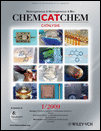 The inaugural issue of ChemCatChem was just published. The chairmen of our Editorial Board have very kindly provided us with their thoughts on the important role that catalysis plays today and, even more importantly, the important role that ChemCatChem will play in the future. Read the musings of Uwe Bornscheuer, Luis A. Oro and Bert Weckhuysen now.
The inaugural issue of ChemCatChem was just published. The chairmen of our Editorial Board have very kindly provided us with their thoughts on the important role that catalysis plays today and, even more importantly, the important role that ChemCatChem will play in the future. Read the musings of Uwe Bornscheuer, Luis A. Oro and Bert Weckhuysen now.
Besides this editorial content, we are also very proud to bring you a triumvirate of extremely timely and enlightening review articles, covering all three of the major catalytic disciplines. Matthias Beller discusses all that is state-of-the-art in Palladium-catalyzed carbonylation reactions of alkenes and alkynes, Uwe Bornscheuer sums up the latest biocatalytic routes to optically active amines and last, but by no means least, Wolfgang Schmidt brings you his thoughts on solid catalysts on the nanoscale: design of complex morphologies and pore structures. All of these, as well as the cream of original catalysis research from all over the world, are available to read free of charge right now.
July 29, 2009
Follow Angewandte Chemie on Twitter, Connect through Facebook
 You can now learn about the latest articles in Angewandte Chemie on your favorite social network. Follow the hottest journal in chemistry through the website, your mobile phone, many social networking sites, and more. We will post all EarlyView articles and more exciting news.
You can now learn about the latest articles in Angewandte Chemie on your favorite social network. Follow the hottest journal in chemistry through the website, your mobile phone, many social networking sites, and more. We will post all EarlyView articles and more exciting news.
August 07, 2008
Discussion: More Realism in the Matter of Predicting Molecules?
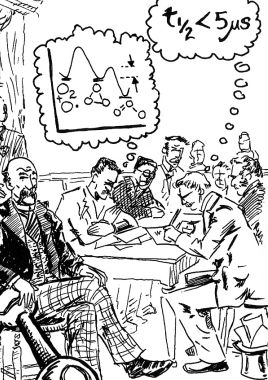 When the above-mentioned Essay by R. Hoffmann, P. v. R. Schleyer and H. F. Schaefer III hit the editor's desk, it was clear that the decision was not going to be an easy one. The manuscript was certainly thought-provoking and, obviously, well written. In essence, the authors appeal to their fellow scientists to present their data in a fashion suitable for the intended audience. For example, it should be clear as to what kind of stability is meant when they write about stable compounds. But is it suitable for Angewandte Chemie? Or rather for a more general magazine-type journal, or a membership newsletter?
When the above-mentioned Essay by R. Hoffmann, P. v. R. Schleyer and H. F. Schaefer III hit the editor's desk, it was clear that the decision was not going to be an easy one. The manuscript was certainly thought-provoking and, obviously, well written. In essence, the authors appeal to their fellow scientists to present their data in a fashion suitable for the intended audience. For example, it should be clear as to what kind of stability is meant when they write about stable compounds. But is it suitable for Angewandte Chemie? Or rather for a more general magazine-type journal, or a membership newsletter?
At the end of the day, and after much discussion with the authors, referees, and the Chairman of the Editorial Board, we decided to publish the manuscript along with the referees' comments and to invite even more comments from the readers.
Please join our debate page to read
- Hoffmann et al's essay: "Predicting Molecules—More Realism, Please!"
- The referee reports by M. Bickelhaupt, G. Frenking, W. Koch, and M. Reiher and
- Readers' comments, most recently by Sason Shaik, who looks at the bigger picture.
If you have thoughts on this issue, whether brief or detailed, please e-mail them to us at [email protected], and we will post them here.
June 18, 2008
Journal Impact Factors 2007: Angewandte Strong Again
For the second year in a row, Angewandte Chemie was assigned an impact factor above 10 (10.031) in Thomson–ISI's Journal Citation Report. The journal leaves strong competitors such as Proceedings of the National Academy of Sciences, Journal of the American Chemical Society, and Chemical Communications behind and remains the top journal in the category "chemistry, multidisciplinary" that publishes original research. The German Chemical Society (GDCh) and publishers are happy to thank all authors, referees, and readers for their tremendous efforts towards the journal's success.
See the list of most cited articles published in 2005/2006, which are the basis for the Journal Citation Report just published.
May 16, 2008
Two Prizes to T. Hayashi
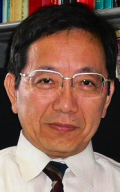 Tamio Hayashi (Kyoto University) receives the US$10000 Ryoji Noyori Prize of the Society of Synthetic Organic Chemistry (Japan) and an Arthur C. Cope Scholar Award from the American Chemical Society. Hayashi is thus recognized for his work on asymmetric transition-metal-catalyzed C–C coupling. Amongst his interests are palladium-catalyzed cross-coupling, gold-catalyzed aldol reactions, and rhodium-catalyzed additions. He recently reported in Angewandte Chemie on the rhodium-catalyzed rearrangement of arylbis(alkynyl)carbinols to 3-alkynyl-1-indanones[1] and the palladium-catalyzed asymmetric [3+3] cycloaddition of trimethylenemethane derivatives with nitrones.[1]
Tamio Hayashi (Kyoto University) receives the US$10000 Ryoji Noyori Prize of the Society of Synthetic Organic Chemistry (Japan) and an Arthur C. Cope Scholar Award from the American Chemical Society. Hayashi is thus recognized for his work on asymmetric transition-metal-catalyzed C–C coupling. Amongst his interests are palladium-catalyzed cross-coupling, gold-catalyzed aldol reactions, and rhodium-catalyzed additions. He recently reported in Angewandte Chemie on the rhodium-catalyzed rearrangement of arylbis(alkynyl)carbinols to 3-alkynyl-1-indanones[1] and the palladium-catalyzed asymmetric [3+3] cycloaddition of trimethylenemethane derivatives with nitrones.[1]
Hayashi studied at Kyoto University and received his PhD there in 1975 under the supervision of M. Kumada. Between 1976 and 1977 he worked as a postdoctoral fellow at the Colorado State University in Fort Collins (USA) with L. S. Hegedus and thereafter returned to Kyoto University. Between 1989 and 1994 he was a professor at Hokkaido University, and in 1994 he was made a professor at Kyoto University. Furthermore, from 2002 to 2005 he was a professor at Hong Kong Polytechnic University. Hayashi is a member of the Editorial Board of Advanced Synthesis & Catalysis.
[1] a) R. Shintani, K. Takatsu, T. Katoh, T. Nishimura, T. Hayashi, Angew. Chem. 2008, 120, 1469; Angew. Chem. Int. Ed. 2008, 47, 1447; b) R. Shintani, S. Park, W.-L. Duan, T. Hayashi, Angew. Chem. 2007, 119, 6005; Angew. Chem. Int. Ed. 2007, 46, 5901.
This news was published in issue 22 of Angewandte Chemie with an incorrect photo. The online version has been corrected; the editors apologize for this unfortunate error.
February 19, 2008
Hot Off the (e)Press: First Issue of ChemSusChem
 ChemSusChem is a new journal which is aimed to become a top interdisciplinary journal for research at the interface of chemistry and sustainability with energy research, materials science, chemical engineering, and biotechnology. ChemSusChem is published on behalf of the Editorial Union of Chemical Societies (EUChemSoc). Founding societies are the Società Chimica Italiana and the Gesellschaft Deutscher Chemiker (GDCh). The journal is supported by the Asian Chemical Editorial Society (ACES). Today, the first issue of this new journal was published online. Read the articles free of charge, for example:
ChemSusChem is a new journal which is aimed to become a top interdisciplinary journal for research at the interface of chemistry and sustainability with energy research, materials science, chemical engineering, and biotechnology. ChemSusChem is published on behalf of the Editorial Union of Chemical Societies (EUChemSoc). Founding societies are the Società Chimica Italiana and the Gesellschaft Deutscher Chemiker (GDCh). The journal is supported by the Asian Chemical Editorial Society (ACES). Today, the first issue of this new journal was published online. Read the articles free of charge, for example:
- SusChem: From Vision to Action [Essay]
Marian Mours - Chemoenzymatic Synthesis and Chemical Recycling of Sustainable Polyurethanes [Full Paper]
Yoshio Yanagishita, Makoto Kato, Kazunobu Toshima, Shuichi Matsumura - Chemicals from Renewables: Aerobic Oxidation of Furfural and Hydroxymethylfurfural over Gold Catalysts [Communication]
Esben Taarning, Inger S. Nielsen, Kresten Egeblad, Robert Madsen, Claus H. Christensen - Photochemical Conversion of Solar Energy [Review]
Vincenzo Balzani, Alberto Credi, Margherita Venturi
as well as the Editorials by the editors ("Sustainability: Chemistry Is Key") and editorial board chairmen M. Beller ("Opportunities Abound"), G. Centi ("Excellence in Innovation"), and D. G. Nocera ("Great Challenges Ahead).
Institutions can opt-in to complimentary access throughout 2008. Ask your librarian about it.
Don't miss a new article or issue with ChemSusChem's EarlyView RSS feed and table of contents alerts. They're free!
January 31, 2008
Burckhardt Helferich Prize to P. Gölitz
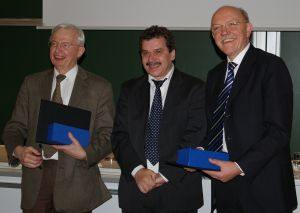 Since 2005, the University of Leipzig has awarded the Burckhardt Helferich Prize. The presentation of the prizes for 2007 and 2008 by Athanassios Giannis (center) took place in January for both recipients together: Jean-Marie Lehn (2007, left) and Peter Gölitz (2008, right).
Since 2005, the University of Leipzig has awarded the Burckhardt Helferich Prize. The presentation of the prizes for 2007 and 2008 by Athanassios Giannis (center) took place in January for both recipients together: Jean-Marie Lehn (2007, left) and Peter Gölitz (2008, right).
Gölitz (Wiley-VCH, Weinheim) studied chemistry at the University of Göttingen and received his PhD in 1978 under the supervision of A. de Meijere on highly strained small-ring propellanes and trifluoromethylations. From 1978 to 1979 he had a postdoctoral stay at the IBM Research Laboratories in San José, CA (USA), and thereafter a further ten months with de Meijere, who was now at the University of Hamburg. On October 1, 1980, he started work as an editor with Angewandte Chemie at the then Verlag Chemie in Weinheim. Only two years later, on November 1, 1982, has was made editor-in-chief of the journal, which has substantially grown and become more international over the past 25 years. Gölitz has regularly reported on the development in Editorials.[3] Gölitz played a pivotal role in the development of eight journals, including Advanced Materials (1988), Chemistry—A European Journal (1995), and recently ChemSusChem, whose first issue is about to be published (articles are available online). For his achievements, the German Chemical Society (Gesellschaft Deutscher Chemiker) presented him with the Gmelin–Beilstein Memorial Medal in 2000, and in 2005 the Société Française de Chimie awarded him their Medaille. In 2007 he was presented the German Language Cultural Prize for Institutions on behalf of the editorial office of Angewandte Chemie.
[3] P. Gölitz, Angew. Chem. 2007, 119, 6866; Angew. Chem. Int. Ed. 2007, 46, 6744; P. Gölitz, Angew. Chem. 2008, 120, 5; Angew. Chem. Int. Ed. 2008, 47, 5.
January 30, 2008
A. Kreimeyer on the Editorial Board of Angewandte Chemie
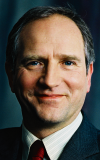 Stefan Marcinowski has left the Editorial Board of Angewandte Chemie at his own request, owing to a reallocation of duties on the Board of Executive Directors of BASF. The Board of the German Chemical Society (Gesellschaft Deutscher Chemiker, GDCh) has chosen his colleague and BASF Research Executive Director Andreas Kreimeyer to be his successor.
Stefan Marcinowski has left the Editorial Board of Angewandte Chemie at his own request, owing to a reallocation of duties on the Board of Executive Directors of BASF. The Board of the German Chemical Society (Gesellschaft Deutscher Chemiker, GDCh) has chosen his colleague and BASF Research Executive Director Andreas Kreimeyer to be his successor.
Kreimeyer studied biology at the Universities of Hanover and Hamburg. After receiving his PhD under the supervision of H. Hilz (Institute of Physiological Chemistry) on ADP ribosylation associated with DNA repair in vivo, he joined the main laboratory of BASF in 1986. In 1993 he was made Personal Assistant to the Chairman of the Board of Executive Directors, and in 1995 he moved to Singapore. From 1998 to 2002 he led successively the divisions of fertilizers, dispersions, and functional polymers. On January 1, 2003 he was appointed to the Board of Executive Directors, and since 2006 he has also been Chairman of the Supervisory Board of BASF Coatings, Münster.
October 30, 2007
Angewandte Chemie Recognized
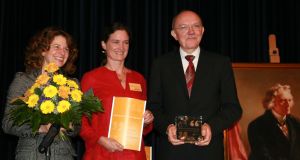 This weekend, Editor Peter Gölitz (left; right: Wiley-VCH's VP and executive director Eva Wille) received the "Kulturpreis Deutsche Sprache" (German Language Culture Award) from the Eberhard Schöck Foundation and the Association for German Language (Verein Deutsche Sprache). "The journal is recognized for promoting German as a language of science, thereby helping science education at all levels and outreach of chemistry to the general public in German-language countries," said Felicitas Schöck (center) on behalf of the jury.
This weekend, Editor Peter Gölitz (left; right: Wiley-VCH's VP and executive director Eva Wille) received the "Kulturpreis Deutsche Sprache" (German Language Culture Award) from the Eberhard Schöck Foundation and the Association for German Language (Verein Deutsche Sprache). "The journal is recognized for promoting German as a language of science, thereby helping science education at all levels and outreach of chemistry to the general public in German-language countries," said Felicitas Schöck (center) on behalf of the jury.
Further awards were given to Frank Schirrmacher (editor of Frankfurter Allgemeine Zeitung) and the German Library in Helsinki.
June 20, 2007
Angewandte Chemie Sky-High
For the first time in its publishing history, Angewandte Chemie has received a double-digit journal impact factor from ISI: 10.232 (2006; 2005: 9.596). Roughly speaking, the impact factor is the ratio of citations and published articles in the past two years. Angewandte Chemie maintains its status as the leading journal of its kind, leaving journals such as the Journal of the American Chemical Society (7.696; 2005: 7.419) or Chemical Communications (4.521; 2005: 4.426) far behind both in terms of the absolute value and relative growth. While the reviews in Angewandte Chemie do contribute to the journal's higher impact factor, it is not as much as commonly believed: Its impact factor is much higher than the combined impact factors of e.g. J. Am. Chem. Soc. and Chem. Rev. or Chem. Commun. and Chem. Soc. Rev.
The editors extend their gratitude to authors, referees, and readers, as well as to the Members of its Boards and the German Chemical Society (GDCh) for their support. The team will keep working hard to bring customers the best chemistry journal.
October 02, 2006
RNA Interference Earns Fire, Mello Nobel Prize
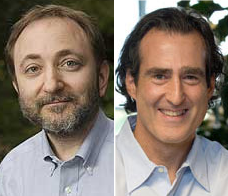 The Nobel Assembly at Karolinska Institutet (Stockholm, Sweden) has today decided to award the Nobel Prize in Physiology or Medicine for 2006 jointly to Andrew Z. Fire (Stanford University, USA) and Craig C. Mello (University of Massachusetts, Worcester, USA) for their discovery of "RNA interference—gene silencing by double-stranded RNA".
The Nobel Assembly at Karolinska Institutet (Stockholm, Sweden) has today decided to award the Nobel Prize in Physiology or Medicine for 2006 jointly to Andrew Z. Fire (Stanford University, USA) and Craig C. Mello (University of Massachusetts, Worcester, USA) for their discovery of "RNA interference—gene silencing by double-stranded RNA".
Learn more and stay updated about the latest RNA research in Angewandte Chemie and its sister journals by browsing our "Hot Topic: RNA" page. Go there now.
July 21, 2006
Angewandte's Impact Shown to Increase Again
In their latest Journal Citation Report, Thomson ISI announced that the Journal Impact Factor of Angewandte Chemie has risen again to 9.596 over 9.161 in the prior year. The impact factor is a measure of the importance of a journal in terms of citations. It is calculated as the number of citations to articles published in the two preceeding years divided by the number of articles published in that time. It is often said that Angewandte's impact factor is higher than JACS' or ChemComm's because it includes reviews, which are cited more often than original papers. As a matter of fact, it is still higher than the combined impact factors of JACS/Chem. Rev. or Chem. Commun./Chem. Soc. Rev.; the ratio of added article numbes and citations of these pairs of journals is 8.116 and 4.744, respectively.
Publishers and owners alike are extremely pleased with another year of growth and wish to extend their thanks to all authors, referees, and readers.
July 10, 2006
ChemMedChem now accepted in MEDLINE
ChemMedChem, the new journal at the interface of chemistry, biology, and medicinal and pharmaceutical sciences, had a successful start at the beginning of this year. Now the U.S. National Library of Medicine has confirmed the acceptance of ChemMedChem for coverage in MEDLINE.
The new journal, published on behalf of the Editorial Union of Chemical Societies (EUChemSoc), is well on its way to becoming indispensable reading. See for yourself how your research can benefit from this new publication and recommend ChemMedChem for your library. Ask your librarian to register for free access throughout 2006 at http://www3.interscience.wiley.com/aboutus/new_journals_2006_opt-in.html
March 22, 2006
Chemistry—An Asian Journal Welcomes Singapore and Taiwan, China
Chemistry—An Asian Journaland the Asian Chemical Editorial Society (ACES) welcome two new partner societies, the Chemical Society Located in Taipei and the Singapore National Institute of Chemistry. On behalf of six Asian chemical societies, the journal will be published monthly from mid-2006.
- Chemical Research Society of India
- Chemical Society of Japan
- Chemical Society Located in Taipei
- Chinese Chemical Society
- Korean Chemical Society
- Singapore National Institute of Chemistry
Chemistry—An Asian Journal is also supported by the Gesellschaft Deutscher Chemiker (German Chemical Society). The new journal is included in institutional print subscriptions to Angewandte Chemie, complimentary online access is available upon request.
February 02, 2006
First Issue of ChemMedChem Published
 The first issue of ChemMedChem, Angewandte's new monthly sister journal of chemistry and drug discovery has been published and features exciting contributions on the process from both academia and industry. ChemMedChem is co-owned by the German and Italian Chemical Societies with board co-chairmen Rainer Metternich (Berlin, Germany) and Georgio Tarzia (Urbino, Italy). It is delivered free with print subscriptions of Angewandte, institutions may opt into free online access, you can view a free online sample copy or order a free print sample copy. And remember to send it your best manuscripts in chemistry enabling drug discovery! See the journal's homepage for current and upcoming contents and more...
The first issue of ChemMedChem, Angewandte's new monthly sister journal of chemistry and drug discovery has been published and features exciting contributions on the process from both academia and industry. ChemMedChem is co-owned by the German and Italian Chemical Societies with board co-chairmen Rainer Metternich (Berlin, Germany) and Georgio Tarzia (Urbino, Italy). It is delivered free with print subscriptions of Angewandte, institutions may opt into free online access, you can view a free online sample copy or order a free print sample copy. And remember to send it your best manuscripts in chemistry enabling drug discovery! See the journal's homepage for current and upcoming contents and more...
January 25, 2006
New Members of the International Advisory Board (1)...

Biochemistry: Lia Addadi
L. Addadi studied organic chemistry at the Università degli Studi di Padova (Italy) and obtained her PhD in 1979 from the Weizmann Institute in Rehovot (Israel) under the guidance of M. Lahav. She then worked as a postdoctoral researcher in the group of J. R. Knowles at Harvard University (USA) before returning in 1988 to the Weizmann Institute as a professor. The research interests of her group lie in biomineralization and the interactions of cells, proteins, and antibodies with crystals. Addadi serves as a member of the advisory board for ChemBioChem, and recently discussed therein the concept of the spatial and temporal sequence of events during cell adhesion, and reported on a new family of proteins rich in aspartic acid from the prismatic shell matrix of the bivalve Atrina rigida.[3]
Novel Materials: Chun-Li Bai
C.-L. Bai obtained his PhD in 1985 from the Institute of Chemistry of the Chinese Academy of Sciences in Beijing. After a postdoctoral stay at the California Institute of Technology in Pasadena (USA), he returned to China in 1987. During 1991–92, he was a visiting professor in Japan at the University of Tohoku in Sendai. Bai is interested in the development of new scanning probe microscopes for surface analysis. He recently reported in Angewandte Chemie on the mass production and high photocatalytic activity of ZnS nanoporous nanoparticles, and in ChemPhysChem on the effect of polarity on co-adsorbed molecular nanostructures of substituted phthalocyanine and thiol molecules.[4] Bai is Executive Vice-President of the Chinese Academy of Sciences and President of the Chinese Chemical Society.
Medicinal Chemistry: Scott Biller
S. Biller is Head of Global Discovery Chemistry at the Novartis Institutes for Biomedical Research and is responsible for projects in combinatorial, medicinal, and computational chemistry across the Novartis sites in Basel, Cambridge (MA), Vienna, and Horsham (UK). He carried out undergraduate research with K. B. Sharpless (Massachusetts Institute of Technology, USA), completed his PhD in 1982 with D. Evans at the California Institute of Technology, and then worked as a postdoctoral fellow with G. Stork at Columbia University in New York (1982–83). During his career he has held many key positions in the field of drug development, including Vice-President of Pharmaceutical Candidate Optimization at Bristol–Myers Squibb (BMS), Head of Discovery Chemistry at BMS, and Executive Director of Metabolic Diseases Chemistry.
[3] a) M. Cohen, D. Joester, B. Geiger, L. Addadi, ChemBioChem 2004, 5, 1393, b) B.-A. Gotliv, N. Kessler, J. L. Sumerel, D. E. Morse, N. Tuross, L. Addadi, S. Weiner, ChemBioChem 2005, 6, 304.
[4] a) J.-S. Hu, L.-L. Ren, Y.-G. Guo, H.-P. Liang, A.-M. Cao, L.-J. Wan, C.-L. Bai, Angew. Chem. 2005, 117, 1295; Angew. Chem. Int. Ed. 2005, 44, 1269, b) Z.-Y- Yang, S.-B. Lei, L.-H. Gan, L.-J. Wan, C. Wang, C.-L. Bai, ChemPhysChem 2005, 6, 65.
October 28, 2005
ChemMedChem: First Articles Published
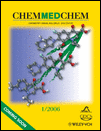 Today, the first articles of ChemMedChem were published online, they are accessible free of charge. ChemMedChem is the new journal on drug discovery of the Italian and German Chemical Societies published by Wiley-VCH. Read more.
Today, the first articles of ChemMedChem were published online, they are accessible free of charge. ChemMedChem is the new journal on drug discovery of the Italian and German Chemical Societies published by Wiley-VCH. Read more.
October 05, 2005
Nobel Prize in Chemistry 2005 for Chauvin/Grubbs/Schrock
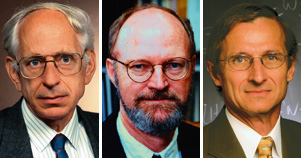 The Royal Swedish Academy of Sciences has decided to award the Nobel Prize in Chemistry for 2005 jointly to Yves Chauvin (Institut Français du Pétrole, Rueil-Malmaison, France, left), Robert H. Grubbs (California Institute of Technology (Caltech), Pasadena, CA, USA, middle), and Richard R. Schrock (Massachusetts Institute of Technology (MIT), Cambridge, MA, USA, right) for the development of the metathesis method in organic synthesis.
The Royal Swedish Academy of Sciences has decided to award the Nobel Prize in Chemistry for 2005 jointly to Yves Chauvin (Institut Français du Pétrole, Rueil-Malmaison, France, left), Robert H. Grubbs (California Institute of Technology (Caltech), Pasadena, CA, USA, middle), and Richard R. Schrock (Massachusetts Institute of Technology (MIT), Cambridge, MA, USA, right) for the development of the metathesis method in organic synthesis.
Only three weeks ago, Grubbs and Schrock received the German Chemical Society's prestigious August Wilhelm von Hofmann Medal. Both are members of the Academic Advisory Board of Advanced Synthesis & Catalysis. Find out more in
- R. Grubbs (Ed.), Handbook of Metathesis, Wiley-VCH, Weinheim, 2003; R. H. Grubbs, T. M. Trnka in Ruthenium in Organic Synthesis (Ed. S.-I. Murahashi), Wiley-VCH, Weinheim, 2004, pp. 153û177.
- R. R. Schrock, A. H. Hoveyda, Angew. Chem. 2003, 115, 4740; Angew. Chem. Int. Ed. 2003, 42, 4592.
- J.-L. Hérisson, Y. Chauvin, Makromol. Chem. 1971, 141, 161.
See also:
- K. C. Nicolaou, P. G. Bulger, D. Sarlah, Angew. Chem. 2005, 117, 4564; Angew. Chem. Int. Ed. 2005, 44, 4490.
October 04, 2005
Silver Jubilee for Peter Gölitz
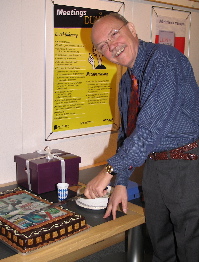 When Peter Gölitz joined the Angewandte team in 1980, no more than 300 communications were published in the journal each year (mostly from Germany) and its impact factor was only about 4. He became Editor-in-Chief only two years later. This year, around 1300 communications (mostly from outside Germany) will be published, and the impact factor is just over 9. In addition, he helped to launch no less than seven new journals. A well-deserved celebratory cake...
When Peter Gölitz joined the Angewandte team in 1980, no more than 300 communications were published in the journal each year (mostly from Germany) and its impact factor was only about 4. He became Editor-in-Chief only two years later. This year, around 1300 communications (mostly from outside Germany) will be published, and the impact factor is just over 9. In addition, he helped to launch no less than seven new journals. A well-deserved celebratory cake...
June 20, 2005
Increased Impact for Wiley-VCH Chemistry and Materials Journals
Today, the Institute for Scientific Information released its annual Journal Citation report, which includes Journal Impact Factors 2004. The Journal Impact Factor is calculated as the number of citations in a given year (2004) to articles published in the two preceeding years (2002-2003) divided by the number of articles published in the two preceeding years (2002-2003).
In the chemistry section, the 2004 impact factor of Angewandte Chemie is 9.161 (up from 8.427 in 2003—the highest ever), Chemistry—A European Journal celebrates not just its 10th anniversary, but also an increase from 4.353 to 4.517. Their sister journals ChemPhysChem and ChemBioChem enjoy results of 3.596 (2003: 3.316) and 3.474 (2003: 3.992), respectively, to confirm the success on their way to becoming premier international journals. The Journal Impact Factors of European Journals of Organic and Inorganic Chemistry are at 2.426 (2003: 2.227) and 2.336 (2003: 2.482). Advanced Synthesis & Catalysis rises to 4.482 (2003: 3.783).
For comparison: J. Am. Chem. Soc.: 6.903, Chem. Commun. 3.997,
J. Chem. Phys. B 3.834, Phys. Chem. Chem. Phys. 2.076,
J. Biol. Chem. 6.335, Biol. Chem. 3.598.
On the materials side, the impact factors of Advanced Materials, Advanced Functional Materials, and Chemical Vapor Deposition have also climbed significantly: 8.079 (2003: 7.305), 5.679 (2003: 4.798), and 2.209 (2003: 2.071).
For comparison: Nat. Mater. 13.5, Chem. Mater. 4.103, J. Mater. Chem. 2.721.
The publishers would like to take this opportunity to thank all authors, referees, and readers for their continued trust and support.
February 24, 2005
The Best Reviews in Angewandte Chemie 2004...
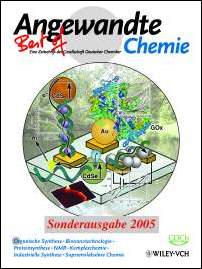 The German Chemical Society (GDCh) asked faculty members at four randomly chosen German universities (Bremen, Jena, Frankfurt/M., and Karlsruhe) as well as 40 randomly chosen Angewandte authors and 20 referees from industry for their opinion on the reviews published in Angewandte Chemie in 2004. The list below shows the winning reviews. They will be published in a special issue in the beginning of March (German only, order now).
The German Chemical Society (GDCh) asked faculty members at four randomly chosen German universities (Bremen, Jena, Frankfurt/M., and Karlsruhe) as well as 40 randomly chosen Angewandte authors and 20 referees from industry for their opinion on the reviews published in Angewandte Chemie in 2004. The list below shows the winning reviews. They will be published in a special issue in the beginning of March (German only, order now).
- C. Oliver Kappe*
Controlled Microwave Heating in Modern Organic Synthesis
Angew. Chem. 2004, 116, 6408–6443; Angew. Chem. Int. Ed. 2004, 43, 6250–6284 - Teruaki Mukaiyama*
Explorations into New Reaction Chemistry
Angew. Chem. 2004, 116, 5708–5733; Angew. Chem. Int. Ed. 2004, 43, 5590–5614 - Eugenii Katz, Itamar Willner*
Integrated Nanoparticle–Biomolecule Hybrid Systems: Synthesis, Properties, and Applications
Angew. Chem. 2004, 116, 6166–6235; Angew. Chem. Int. Ed. 2004, 43, 6042–6108 - Timm Graening, Hans-Günther Schmalz*
Total Syntheses of Colchicine in Comparison: A Journey through 50 Years of Synthetic Organic Chemistry
Angew. Chem. 2004, 116, 3292–3318; Angew. Chem. Int. Ed. 2004, 43, 3230–3256 - Peter I. Dalko*, Lionel Moisan
In the Golden Age of Organocatalysis
Angew. Chem. 2004, 116, 5248–5286; Angew. Chem. Int. Ed. 2004, 43, 5138–5175 - Nediljko Budisa*
Prolegomena to Future Experimental Efforts on Genetic Code Engineering by Expanding Its Amino Acid Repertoire
Angew. Chem. 2004, 116, 6586–6624; Angew. Chem. Int. Ed. 2004, 43, 6426–6463 - Steve W. Homans*
NMR Spectroscopy Tools for Structure-Aided Drug Design
Angew. Chem. 2004, 116, 292–303; Angew. Chem. Int. Ed. 2004, 43, 290–300 - Xiaoyu Li, David R. Liu*
DNA-Templated Organic Synthesis: Nature's Strategy for Controlling Chemical Reactivity Applied to Synthetic Molecules
Angew. Chem. 2004, 116, 4956–4979; Angew. Chem. Int. Ed. 2004, 43, 4848–4870 - Ingo Krossing*, Ines Raabe
Noncoordinating Anions—Fact or Fiction? A Survey of Likely Candidates
Angew. Chem. 2004, 116, 2116–2142; Angew. Chem. Int. Ed. 2004, 43, 2066–2090 - Dudley H. Williams*, Elaine Stephens, Dominic P. O'Brien, Min Zhou
Understanding Noncovalent Interactions: Ligand Binding Energy and Catalytic Efficiency from Ligand-Induced Reductions in Motion within Receptors and Enzymes
Angew. Chem. 2004, 116, 6760–6782; Angew. Chem. Int. Ed. 2004, 43, 6596–6616 - Michael Breuer, Klaus Ditrich, Tilo Habicher, Bernhard Hauer*, Maria Keßeler, Rainer Stürmer, Thomas Zelinski
Industrial Methods for the Production of Optically Active Intermediates
Angew. Chem. 2004, 116, 806–843; Angew. Chem. Int. Ed. 2004, 43, 788–824 - Pekka Pyykkö*
Theoretical Chemistry of Gold
Angew. Chem. 2004, 116, 4512–4557; Angew. Chem. Int. Ed. 2004, 43, 4412–4456
February 15, 2005
Most Popular Articles in January 2005
Over the past month, the following articles were the most popular full-text downloads from Angewandte Chemie International Edition:
- Catalysts for Cross-Coupling Reactions with Non-activated Alkyl Halides (Vol. 44, No. 5)
- Short, Enantioselective Total Synthesis of Stephacidin A (Vol. 44, No. 4)
- Enantioselective Total Synthesis of Cylindramide (Vol. 44, No. 5)
- The Total Synthesis of the Annonaceous Acetogenin 10-Hydroxyasimicin (Vol. 44, No. 4)
- Direct Coupling of Pyrroles with Carbonyl Compounds: Short Enantioselective Synthesis of (S)-Ketorolac... (Vol. 44, No. 4)
- Monoligated Palladium Species as Catalysts in Cross-Coupling Reactions (Vol. 44, No. 3)
- The Quest for Quinine: Those Who Won the Battles and Those Who Won the War (Vol. 44, No. 6)
- Nucleophile-Catalyzed Asymmetric Acylations of Silyl Ketene Imines: Application to the Enantioselective Synthesis of Verapamil (Vol. 44, No. 6)
- Biomimetic Total Synthesis of Gambogin and Rate Acceleration of Pericyclic Reactions in Aqueous Media (Vol. 44, No. 5)
- Highly Enantioselective Thiourea-Catalyzed Nitro-Mannich Reactions (Vol. 44, No. 3)
December 07, 2004
Most Popular Articles in November 2004
Over the past month, the following articles were the most popular full-text downloads from Angewandte Chemie International Edition:
- Controlled Microwave Heating in Modern Organic Synthesis (Vol. 43, No. 46)
- Integrated Nanoparticle-Biomolecule Hybrid Systems: Synthesis, Properties, and Applications (Vol. 43, No. 45)
- The Woodward-Hoffmann-Rules ... (EarlyView)
- Total Synthesis of Apicularen A through Transannular Pyran Formation; (Vol. 43, No. 43)
- A Claim on the Development of the Frontier Orbital Explanation of Electrocyclic Reactions (EarlyView)
- Enantioselective Catalysis with Chiral Phosphine Oxide Preligands (Vol. 43, No. 44)
- Asymmetric Synthesis of Highly Substituted β-Lactones by Nucleophile-Catalyzed [2+2] Cycloadditions of Disubstituted Ketenes with Aldehydes (Vol. 43, No. 46)
- Enantioselective Total Synthesis of (+)-Milnamide A and Evidence of Its Autoxidation to (+)-Milnamide D (Vol. 43, No. 44)
- Pyrrole Syntheses by Multicomponent Coupling Reactions (Vol. 43, No. 46)
- Readily Available Biaryl P,N Ligands for Asymmetric Catalysis (Vol. 43, No. 44)
November 02, 2004
Most Popular Articles in October 2004
Over the past month, the following articles were the most popular full-text downloads from Angewandte Chemie International Edition:
- Explorations into New Reaction Chemistry (Vol. 43, No. 42)
- Syntheses of Tetrodotoxin (Vol. 43, No. 42)
- In the Golden Age of Organocatalysis (Vol. 43, No. 39)
- Quantifying Intermolecular Interactions: Guidelines for the Molecular Recognition Toolbox (Vol. 43, No. 40)
- Evolution of Carbonylation Catalysis: No Need for Carbon Monoxide (Vol. 43, No. 42)
- Finite, Spherical Coordination Networks that Self-Organize from 36 Small Components (Vol. 43, No. 42)
- Nucleophilic Catalysis by 4-(Dialkylamino)pyridines Revisited - The Search for Optimal Reactivity and Selectivity (Vol. 43, No. 41)
- Highly Enantioselective Direct Organocatalytic α-Chlorination of Ketones (Vol. 43, No. 41)
- The Strongest Isolable Acid (Vol. 43, No. 40)
- Outrunning the Bear (Vol. 43, No. 42)
October 15, 2004
New in ChemPhysChem and ChemBioChem: Articles Published Online As Soon As Possible
So far, the contents of Angewandte's sister journals has been published online through Wiley InterScience one or two weeks before print. But why wait for the next available issue? Both journals now publish all articles under the EarlyView scheme, that is they are posted online as soon as the final corrections are made. This way, they are fully citeable, searchable, cross-referenced, and even indexed in PubMed thanks to the use of digital object identifiers, doi, way before they appear in print. EarlyView articles are also included in our Profiled Alerting service, so you will be notified if they match a search that you specified earlier (learn more). You can browse them through the EarlyView link in the horizontal navigation bar below the cover picture on each journal's homepage.
Articles that appear in EarlyView will typically not have page numbers assigned. Until they do, please refer to them through their doi and publication date:
- Atmospheric Organic Aerosol Production by Heterogeneous Acid-Catalyzed Reactions
Myoseon Jang, Nadine M. Czoschke, Amanda L. Northcross
ChemPhysChem, October 13, 2004, 10.1002/cphc.200301077 - NMR Backbone Assignment of a Protein Kinase Catalytic Domain by a Combination of Several Approaches: Application to the Catalytic Subunit of cAMP-Dependent Protein Kinase
Thomas Langer, Martin Vogtherr, Bettina Elshorst, Marco Betz, Ulrich Schieborr, Krishna Saxena, Harald Schwalbe
ChemBioChem, October 13, 2004, 10.1002/cbic.200400129 - Synthesis and Degradation of Nucleobases and Nucleic Acids by Formamide in the Presence of Montmorillonites
Raffaele Saladino, Claudia Crestini, Umberto Ciambecchini, Fabiana Ciciriello, Giovanna Costanzo, Ernesto Di Mauro
ChemBioChem, October 13, 2004, 10.1002/cbic.200400119 - Identification and Biosynthesis of an Aggregation Pheromone of the Storage Mite Chortoglyphus arcuatus
Stefan Schulz, Jens Fuhlendorff, Johannes L. M. Steidle, Jana Collatz, Jörg-Thomas Franz
ChemBioChem, October 13, 2004, 10.1002/cbic.200400110 - Imaging the Selective Binding of Synapsin to Anionic Membrane Domains
Jill Murray, Louis Cuccia, Anatoli Ianoul, James J. Cheetham, Linda J. Johnston
ChemBioChem, October 13, 2004, 10.1002/cbic.200400097
October 05, 2004
10th Anniversary Celebrations for Chemistry—A European Journal
Hard to believe: Chemistry—A European Journal publishes its 10th volume this year. It was launched in 1995 as a result of discussions between Nobel laureate J.-M. Lehn, GDCh president H. Nöth and Angewandte Editor P. Gölitz. To celebrate this successful decade, the owner societies and Wiley-VCH publishers have organized a free, one-day symposium in Strasbourg on April 15, 2005 with renowned keynote lecturers. You are cordially invited to join—find out more.
October 04, 2004
Nobel Prize in Medicine/Physiology to Richard Axel and Linda B. Buck
Richard Axel (Columbia University, New York, USA) and Linda B. Buck (Fred Hutchinson Cancer Research Center, Seattle, WA, USA) were awarded the 2004 Nobel Prize in Physiology or Medicine for for their discoveries of odorant receptors and the organization of the olfactory system. They discovered a large gene family, comprised of some 1,000 different genes (three per cent of our genes) that give rise to an equivalent number of olfactory receptor types. These receptors are located on the olfactory receptor cells, which occupy a small area in the upper part of the nasal epithelium and detect the inhaled odorant molecules.
August 30, 2004
Editorial Note: Diamond Synthesis in Doubt
Last year in Angewandte Chemie and in the Journal of the American Chemical Society Quianwang Chen et al. reported diamond syntheses from MgCO3-Na and CO2-(Li, Na, K), respectively.[1,2] The authors have apologized for failing to cross-reference the papers and for manipulation of some of the data (see the second paragraph in the Correspondence from Z. Lou and Q. Chen on page 4700).
In addition, the results reported in both publications are heavily criticized by H. Sachdev:[3] The details of the reaction conditions are not reported in sufficient detail for the work to be repeated and the characterizations (or even proof) of the final products are not without doubt; furthermore, the characterization of intermediate products, important for the postulated reaction mechanism, is missing. Even if a diamond synthesis is, in principle, possible under the conditions presumably present in the reaction system used by Chen et al. then its actual realization remains doubtful. Chen and Lou give a series of arguments in their Reply[4] in order to support their diamond synthesis, however, they close with the comment "we could produce diamonds from time to time in MgCO3-Na and CO2-(Li, Na, K) system" (italicized by me), which naturally casts doubts about the reproducibility. Hopefully this Note and the two Correspondences will lead to a rapid resolution of the problem of whether or not diamonds can be prepared by the method of Chen et al.
Peter Gölitz
- Z. S. Lou, Q. W. Chen, W. Wang, Y. T. Qian, Y. F. Zhang, Angew. Chem. 2003, 115, 4639; Angew. Chem. Int. Ed. 2003, 42, 4501.
- Z. S. Lou, Q. W. Chen, Y. F. Zhang, W. Wang, Y. T. Qian, J. Am. Chem. Soc. 2003, 125, 9302.
- H. Sachdev, Angew. Chem. 2004, 116, 4800, Angew. Chem. Int. Ed. 2004, 43, 4696.
- Z. S. Lou, Q. W. Chen, Angew. Chem. 2004, 116, 4804, Angew. Chem. Int. Ed. 2004, 43, 4700.
June 18, 2004
Angewandte's Increasing Impact
The Institute for Scientific Information (ISI) just released its Journal Citation Report 2003. The Journal Impact Factors published therein are a measure of the number of citations per published article in the two preceeding years. Angewandte Chemie has obtained a JIF of 8.427 (2002: 7.671). For comparison: JACS: 6.516, ChemComm: 4.031.
March 15, 2004
Angewandte Chemie Launches New Editorial Office System
Today, Angewandte Chemie has joined the growing number of Wiley-VCH editorial offices that use manuscriptXpress as their editorial office system. No longer will PDF files have to be e-mailed as bulky attachments back and forth between authors, editors, and referees: Instead, the files will be stored on a central server for easy download. Authors and referees only have to register once (if you are already registered with our online submission system, you do not need to register again) and will find their manuscripts and referee reports across journals on a personal homepage at www.manuscriptxpress.org. Actions will be prompted and confirmed by short e-mail messages.
Until now, the following journals used manuscriptXpress: Eur. J. Org. Chem., Eur. J. Inorg. Chem., the Adv. Mater. and Macromolecular families of journals, and Angewandte's sister journals Chem. Eur. J., ChemBioChem, and ChemPhysChem. Today, the Angewandte office is joining them. All journals operate on a common user database, so you need to register your address, research interests, and any address changes only once across journals.
March 08, 2004
Reviews 2003: Competition Results
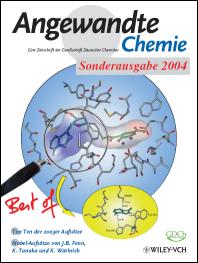 The Gesellschaft Deutscher Chemiker (GDCh, German Chemical Society) has surveyed four chemistry departments in Germany, chosen at random, and 40 German corresponding authors in Angewandte Chemie to determine which Reviews in this journal in 2003 "were best able to offer a prospective chemist a competent, up-to-date, and comprehensive overview of a relevant area of chemistry". The top Reviews based on this survey were printed in a special issue for the Congress of Junior Chemistry Lecturers, together with the 2003 Nobel Lectures by K. Wüthrich, K. Tanaka, and J. B. Fenn on the structural elucidation of large biomolecules by NMR and mass spectrometry. The approximately 350-page issue is to be made available to student members of the GDCh, but will also be used elsewhere for the advertisement of chemistry.
The Gesellschaft Deutscher Chemiker (GDCh, German Chemical Society) has surveyed four chemistry departments in Germany, chosen at random, and 40 German corresponding authors in Angewandte Chemie to determine which Reviews in this journal in 2003 "were best able to offer a prospective chemist a competent, up-to-date, and comprehensive overview of a relevant area of chemistry". The top Reviews based on this survey were printed in a special issue for the Congress of Junior Chemistry Lecturers, together with the 2003 Nobel Lectures by K. Wüthrich, K. Tanaka, and J. B. Fenn on the structural elucidation of large biomolecules by NMR and mass spectrometry. The approximately 350-page issue is to be made available to student members of the GDCh, but will also be used elsewhere for the advertisement of chemistry.
The Reviews that received the most votes were those by Meyer, Castellano, and Diederich (interactions in molecular recognition processes, issue 11), Schrock and Hoveyda (Mo and W olefin-metathesis catalysts, issue 38), Hubbard and Walsh (vancomycin biosynthesis, issue 7), and—perhaps surprisingly—Evers, Staudigl, and co-workers on the preparation of single crystals of silicon and how the method that is still used today came about by chance (issue 46). Next came the Reviews by Copéret, Basset, and co-workers (organometallic chemistry on surfaces, issue 2), Connon and Blechert (olefin cross-metathesis, issue 17), Chen (mass spectrometry and the screening of homogeneous catalysts, issue 25), Fürstner (chemistry and biology of roseophilin and "bleeding hosts", issue 31), Hoffmann (meso compounds, issue 10), and Limberg (radicals in metal-assisted oxygenations, issue 48).
More information is to be found in the editorials by editor-in-chief Peter Gölitz and GDCh president Henning Hopf (in German).
January 19, 2004
F. Diederich New Board Chairman
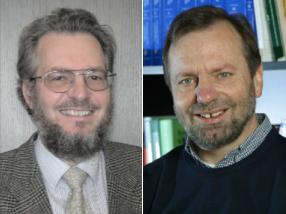 After his second and final term as Chairman of the Editorial Board of Angewandte Chemie in December 2003, Horst Kessler (left) is succeeded by François Diederich (right). The Board advises the Editors on all matters regarding the content and presentation of the journal. Professor Kessler (Tech. Univ. München) has served on the board since 1996 and became chairman in 2000. Find out more about him in the news published in issue 08/2003 on the occasion of his receipt of the Philip Morris Research Award. Kessler continues to serve as a board member. Professor Diederich (ETH Zurich) has been a member of the board since 1995.
After his second and final term as Chairman of the Editorial Board of Angewandte Chemie in December 2003, Horst Kessler (left) is succeeded by François Diederich (right). The Board advises the Editors on all matters regarding the content and presentation of the journal. Professor Kessler (Tech. Univ. München) has served on the board since 1996 and became chairman in 2000. Find out more about him in the news published in issue 08/2003 on the occasion of his receipt of the Philip Morris Research Award. Kessler continues to serve as a board member. Professor Diederich (ETH Zurich) has been a member of the board since 1995.
Hans U. Stilz, Rainer Metternich, Rudolf Thauer, and Nobel laureate Hartmut Michel have joined the Editorial Board. See the news in issue 1/2004 for details.
January 15, 2004
Angewandte Backfiles 1962-1997 Now Online
Effective immediately, Angewandte Chemie International Edition in English 1962–1997 is available online through Wiley InterScience. Users will benefit from access to over 18,000 fully searchable and crosslinked articles, which include over 1800 Reviews. There is a 15% discount for placing an order before January 31, 2004.
July 21, 2003
Warning: DMSO complexes of HIO3 or I2O5 may explode
In a Communication entitled "HIO3 and I2O5: Mild and Selective Alternative Reagents to IBX for the Dehydrogenation of Aldehydes and Ketones",[1] K. C. Nicolaou et al. disclosed new reagents, HIO3·DMSO and I2O5·DMSO complexes for the dehydrogenation of ketones and aldehydes to afford the corresponding enones and enals, respectively. The reagents were prepared by heating either iodic acid (HIO3), or iodine pentoxide (I2O5) in DMSO (1 M solution) for 80 °C for 1 h. This solution thus prepared was then diluted with cyclohexene as co-solvent and employed in the oxidation of a ketone or enone at 45–65 °C. The authors undertook a large series of such reactions on small scale (0.1–0.5 mmol), and also on many occasions made the reagents on a larger scale (up to 2.5 mmol), without incident.
Dr. S. Woodward (University of Nottingham) has subsequently reported to them (personal communication) that during the preparation of HIO3·DMSO on a 42 mmol scale, after 30 min heating at 80 °C, the reaction exploded. The reaction was being stirred using a circulator–heater equipped with a safety cut-out so accidental overheating could be eliminated as cause. No abnormalities were found in the reagents employed.
The authors would like to direct the attention of the reader to the adverse incident reported by Dr. S. Woodward and urge extreme caution in the large-scale implementation of the procedure for making HIO3·DMSO. Until further investigation is completed they suggest the same caution should be applied to the synthesis of the I2O5·DMSO complex.
[1] K. C. Nicolaou, T. Montagnon, P. S. Baran, Angew. Chem. 2002, 114, 1444; Angew. Chem. Int. Ed. 2002, 41, 1386.
June 24, 2003
Very Important Papers: Accelerated Online Publication
Articles judged by the referees or the editor as being either very important or very urgent are immediately edited, proof-read and electronically published once the manuscript has arrived in the editorial office in final form. As long as there is no page number available these articles should be cited in the following manner:
Author(s), Angew. Chem. Int. Ed., online publication date, DOI.
Articles appear in the "Forthcoming Articles" section in Wiley InterScience.
April 01, 2003
Recent Communication from Bell Labs Partly to be Viewed with Caution
The following statement was received by the Editorial Office:
We are writing as co-authors on the following manuscript published in this journal: T. Siegrist, C. Kloc, J. H. Schön, B. Batlogg, R. C. Haddon, S. Berg, G. A. Thomas, Angew. Chem. 2001, 113, 1782; Angew. Chem. Int. Ed. 2001, 40, 1732.
We wish to apprise the readers of the independent investigation conducted at the behest of the Bell Laboratories division of Lucent Technologies Inc. (see full report). The independent committee reviewed concerns related to the validity of data associated with device measurements described in a number of papers that have appeared in the literature.
As a result of the Committee�s findings related to the manuscripts they examined, we are concerned about aspects of the data associated with device measurements presented in the above mentioned Communication. The current–voltage data (SCLC spectroscopy) should be viewed with caution, as should conclusions that rely on those data. We do not have access to the original data and are not in a position to independently confirm the results.
We stand by the X-ray, crystal structure, and morphological results in this Communication; we are confident that they are valid and correct. Conclusions drawn from these results and from our earlier work on these and related compounds remain standing.
Bertram Batlogg, Steffen Berg, Christian Kloc, Gordon A. Thomas, Robert C. Haddon, Theo Siegrist
A similar statement was received concerning ChemPhysChem 2001, 3, 167.
February 14, 2003
Cover Picture of the Year 2002: And the Winners are...
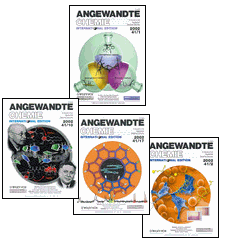 ... Georg Süss-Fink and co-workers (Neuchâtel, Switzerland) who submitted the cover picture of Issue 1 to emphasize supramolecular cluster catalysis, which is commonly regarded as a field lying at the interface of homogeneous and heterogenous catalysis (artwork: T. Ward and C. Thomas). As an example, their Communication reports "[...] Benzene Hydrogenation Catalyzed by a Cationic Triruthenium Cluster under Biphasic Conditions."[1]
... Georg Süss-Fink and co-workers (Neuchâtel, Switzerland) who submitted the cover picture of Issue 1 to emphasize supramolecular cluster catalysis, which is commonly regarded as a field lying at the interface of homogeneous and heterogenous catalysis (artwork: T. Ward and C. Thomas). As an example, their Communication reports "[...] Benzene Hydrogenation Catalyzed by a Cationic Triruthenium Cluster under Biphasic Conditions."[1]
The covers of Issues 10 (Nicolaou/Corey, artwork: R. Echon, S. Snyder), 17 (Vollhardt), and 2 (Waldmann, artwork: P. Herter, G. Schulte) were also very popular among voters.
On the voters' side, the winner drawn among about 1500 participants is Stijn Wuyts, a PhD student at the Catholic University of Leuven, Belgium, who works on racemization reactions, dynamic kinetic resolution, heterogeneous catalysis, enzyme catalysis, and chirality under the supervision of Pierre Jacobs and Dirk De Vos. He will receive a copy of "World Records in Chemistry" by R. Faust et al.
Thank you very much to all participants and congratulations to the winners!
[1] Angew. Chem. 2002, 114, 105; Angew. Chem. Int. Ed. 2002, 41, 99..
December 16, 2002
Starting in January '03: Angewandte Chemie Weekly
"Back to the future" is the slogan when Angewandte goes weekly in January 2003. From 1898 to 1939, it was also delivered to its readers at this frequency. Now, curiosity can again be satisfied more frequently, and the more interesting pieces be studied on a quiet afternoon. The change in frequency was decided after in-depth discussions with the Editorial and Advisory Board as well as the Board of the German Chemical Society. Readers will use their subscriptions more intensively, each article receives more attention. For these reasons, the decision was made for more frequent rather than thicker issues. A benefit for authors is that we can publish articles in less than a month in the future should the need occur.
For more details, see the Editorial in Issue 15/2002.
November 12, 2002
Crystal Anniversary for Advanced Materials
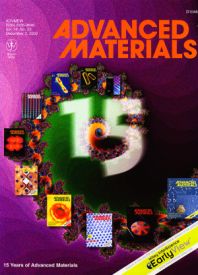 When Advanced Materials was launched 15 years ago, many hoped for it but nobody expected the huge success of this journal. Within 18 months from conception to the first issue, the journal was brought on its way by Angewandte Editor Peter Gölitz. The idea was based on an interview of Gerhard Wegner and Dietrich Haarer in the German Chemical Society membership journal. Its Editor Joachim Rudolph approached Wegner and Haarer and with their support, an international editorial advisory board was set up.
When Advanced Materials was launched 15 years ago, many hoped for it but nobody expected the huge success of this journal. Within 18 months from conception to the first issue, the journal was brought on its way by Angewandte Editor Peter Gölitz. The idea was based on an interview of Gerhard Wegner and Dietrich Haarer in the German Chemical Society membership journal. Its Editor Joachim Rudolph approached Wegner and Haarer and with their support, an international editorial advisory board was set up.
Discussions between publishers and scientists shaped the journal rather than market research. "The outcome would have been: There is no need for a new journal. [...] I think this was at least as good as any market research could be," says Gölitz in an interview with Advanced Materials today. Since the beginning, the focus has been on modern functional materials and not on traditional steel and concrete materials.
In 1990, Peter Gregory took over editorship and the journal became fully independent from its Angewandte piggyback childhood in 1991. "There is no doubt that Advanced Materials has developed at an amazing pace," today's Editor Esther Levy writes in the Editorial of issue 23/2002, which features a special section containing some highlights from the journal's past: an interview with Peter Gölitz, a cover picture gallery, a top author and article list, and a compilation of all Review articles published to date.
"Advanced Materials has turned into a brilliant journal" is the most frequently heard feedback from the scientifc community today.
October 17, 2002
Now Available: 40 Years of Chemistry History
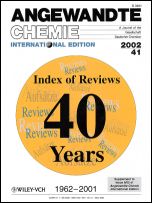
Only available directly from:
|
September 17, 2002
Checking Crystallographic Data
Today, crystallographic data are more complicated than ever. Even experienced researchers may not always see analytic flaws. To make the lives of authors, referees, readers, and editors just a little bit easier, we would like to advertize a free service set up by the International Union of Crystallography. This is based on a rich set of experience with such data: "Checkcif" thoroughly examines crystallographic data in the CIF format for completeness and consistency, and performs geometry and symmetry checks to detect possible errors of analysis, such as high residual electron densities. Authors who submit manuscripts with structural analyses (to be deposited with either CCDC or FIZ Karlsruhe) are kindly asked to supply the report generated by the checkcif service.
March 19, 2002
Cover Picture of The Year Competition: And The Winners Are...
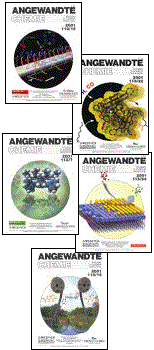 ... the groups of J. Fraser Stoddart and Jeffrey Zink, University of California, Los Angeles, who created the cover picture of Issue 13 to show "molecular motors" at work (artwork by Shinye Chia). Also see the Communication on "Working Supramolecular Machines Trapped in Glass and Mounted on a Film Surface" by Stoddart, Zink et al.
... the groups of J. Fraser Stoddart and Jeffrey Zink, University of California, Los Angeles, who created the cover picture of Issue 13 to show "molecular motors" at work (artwork by Shinye Chia). Also see the Communication on "Working Supramolecular Machines Trapped in Glass and Mounted on a Film Surface" by Stoddart, Zink et al.
The covers of Issues 22 (Reek), 7 (Collmann), 24 (Nolte), and 16 (Jørgensen) were also very poular among voters.
On the voters' side, the winner drawn among about 1000 participants is Gerhard Lang, a PhD student at the University of Würzburg, Germany, who works on the isolation of marine natural products from sponges and microorganisms. He will receive a copy of "Stimulating Concepts in Chemistry" by Vögtle, Stoddart, and Shibasaki.
Thank you very much to all participants and congratulations to the winners!
October 17, 2001
Cambridge Database expands to over 250,000 entries
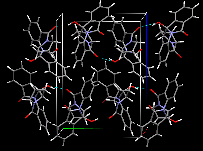 Since October 5th, 2001 the Cambridge Structural Database holds the structures of 250,000 organic and organometallic compounds determined by X-ray or neutron diffraction techniques. The jubilee compound was published by Griesbeck et al. in Angewandte:
Since October 5th, 2001 the Cambridge Structural Database holds the structures of 250,000 organic and organometallic compounds determined by X-ray or neutron diffraction techniques. The jubilee compound was published by Griesbeck et al. in Angewandte:
Diastereo- and Enantioselective Synthesis of Pyrrolo[1,4]benzodiazepines through Decarboxylative Photocyclization
Angew. Chem. Int. Ed. 2001, 40, 577-579.
The database was started in 1965 at the Cambridge Crystallographic Centre (CCDC) with just a few hundred structures.
October 10, 2001
Nobel Prize in Chemistry to Knowles, Noyori, and Sharpless
The Royal Swedish Academy of Sciences has decided to award the Nobel Prize in Chemistry for 2001 for the development of catalytic asymmetric synthesis, with one half jointly to William S. Knowles (*1917; St Louis, Missouri, USA) and Ryoji Noyori (*1938; Nagoya University, Chikusa, Nagoya, Japan) "for their work on chirally catalysed hydrogenation reactions" and the other half to K. Barry Sharpless the Scripps Research Institute, La Jolla, California, USA, "for his work on chirally catalysed oxidation reactions".
William S. Knowles discovered that it was possible to use transition metals to make chiral catalysts for hydrogenation. Ryoji Noyori has led the further development of this process to today's general chiral catalysts for hydrogenation. K. Barry Sharpless, on the other hand, is awarded half of the Prize for developing chiral catalysts for oxidation.
R. Noyori is also the chairman of the Editorial Board of Wiley-VCH's journal Advanced Synthesis & Catalysis and a member of Angewandte's International Advisory Board. K. B. Sharpless is a member of the Academic Advisory Board of Advanced Synthesis & Catalysis. Recent Reviews by the Prize winners in Angewandte include:
- Click Chemistry: Diverse Chemical Function from a Few Good Reactions
by Hartmuth C. Kolb, M. G. Finn, and K. Barry Sharpless - Asymmetric Catalysis by Architectural and Functional Molecular Engineering: Practical Chemo- and Stereoselective Hydrogenation of Ketones
by Ryoji Noyori and Takeshi Ohkuma
October 09, 2001
Nobel Prize in Physics to E. A. Cornell, W. Ketterle, and C. E. Wiemann
The Royal Swedish Academy of Sciences has decided to award the Nobel Prize in Physics for 2001 jointly to Eric A. Cornell (*1961, National Institute of Standards and Technology (NIST), Boulder, Colorado, USA), Wolfgang Ketterle (*1957, Massachusetts Institute of Technology), Carl E. Wieman (*1951, JILA and University of Colorado, Boulder, USA) for the achievement of Bose-Einstein condensation in dilute gases of alkali atoms, and for early fundamental studies of the properties of the condensates. More information is available from the Nobel e-Museum.
October 08, 2001
Nobel Prize in Medicine/Physiology to L. H. Hartwell, R. T. Hunt, and P. M. Nurse
The Nobel Assembly at Karolinska Institutet has today decided to award The Nobel Prize in Physiology or Medicine for 2001 jointly to Leland H. Hartwell (*1939, Fred Hutchinson Cancer Research Center, Seattle, USA), R. Timothy Hunt (*1949, Imperial Cancer Research Fund, London) and Paul M. Nurse (*1943, Imperial Cancer Research Fund, London) for their discoveries of "key regulators of the cell cycle". They have identified key molecules that regulate the cell cycle in all eukaryotic organisms, including yeasts, plants, animals and human. These fundamental discoveries have a great impact on all aspects of cell growth. Defects in cell cycle control may lead to the type of chromosome alterations seen in cancer cells. This may in the long term open new possibilities for cancer treatment. More information is available from the Nobel e-Museum.






































